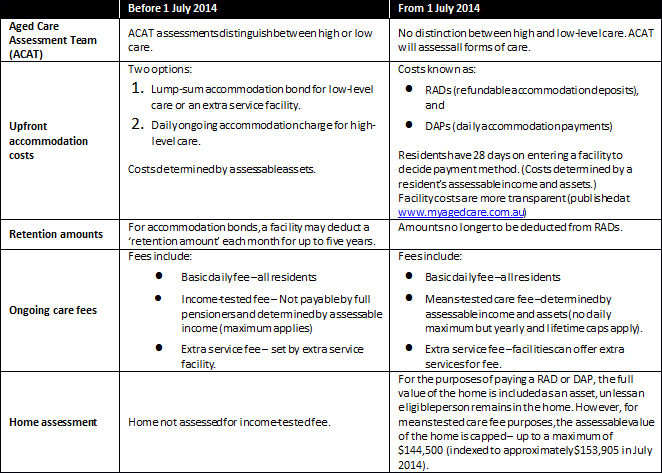The Complex World of Fixed Interest
October 28, 2014Aged care changes in brief
The ‘Living longer, living better’ aged care reforms, which were announced in April 2012 and are scheduled to begin on 1 July 2014. Full details are at www.livinglongerlivingbetter.gov.au.
It is important to note existing residents will be grandfathered under the current rules and new rules will only apply to individuals who enter residential aged care on or after 1 July 2014. Major changes are summarised in the table below.

Here are three guiding principles to help navigate the changes.
Principle #1 – aged care is about more than numbers
Aged care is not a purely technical prospect. First and foremost it is an emotional dilemma. In our experience, when advising families, it is rare that everyone agrees on everything—from the standard of the facility through to geographic location or the type of care.
In terms of financial strategies, there is no ‘one-size-fits-all’ solution. You will need to compare multiple strategies before reaching a decision. One of the difficulties we have also found is that decisions made by family members can sometimes be in their own best interest and have little to do with what’s best for the prospective resident. It can often take time and the intervention of professional advice to get the best result for both the family members and the prospective resident.
Principle #2 – get good advice
It is important to find a professional financial planner that is up to date regarding aged care and Centrelink rules. This should include an understanding of aged care and social security regulations, as well as entitlements for veterans and the overlay of taxation, superannuation, and retirement income streams.
Principle #3 – for better or worse, make the most of the rules
As we approach 30 June 2014, we are often asked whether residents will be better off under the new rules or whether they should bring forward plans to move into aged care.
In modelling the application of the income-tested fee under the current rules and the application of the means-tested fee post-30 June 2014, the cost of care will generally be more expensive under the new regime. The annual and lifetime capping of the means tested fee will make it more affordable for some people, particularly those who are generally healthier and have greater personal wealth.
The set of financial strategies available under the new rules also presents some opportunity. By way of example, since only a portion of the principal residence will be assessed (if not occupied by a protected person), there may be more reason than under the current regime to retain the principal residence.
Source: Australian Unity, 2014
